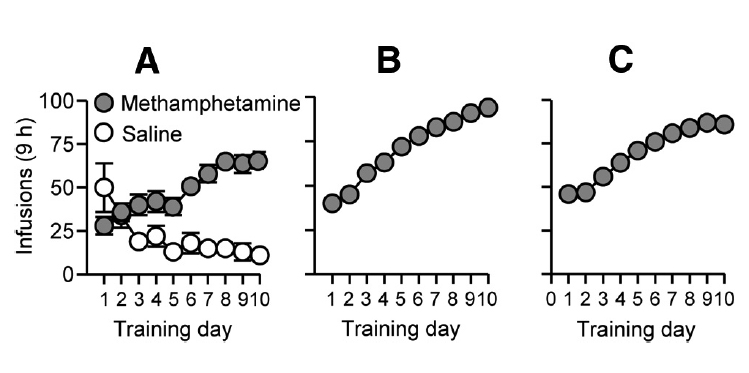Featured Paper of the Month – September 2015
Li, Xuan; Rubio, Javier F; Zeric, Tamara; Bossert, Jennifer M; Kambhampati, Sarita; Cates, Hannah M; Kennedy, Pamela J; Liu, Qing-Rong; Cimbro, Raffaello; Hope, Bruce T; Nestler, Eric J; Shaham, Yavin
In: J Neurosci, vol. 35, no. 21, pp. 8232–8244, 2015, ISSN: 1529-2401 (Electronic); 0270-6474 (Linking).
@article{Li2015,
title = {Incubation of methamphetamine craving is associated with selective increases in expression of Bdnf and trkb, glutamate receptors, and epigenetic enzymes in cue-activated fos-expressing dorsal striatal neurons.},
author = {Xuan Li and Javier F Rubio and Tamara Zeric and Jennifer M Bossert and Sarita Kambhampati and Hannah M Cates and Pamela J Kennedy and Qing-Rong Liu and Raffaello Cimbro and Bruce T Hope and Eric J Nestler and Yavin Shaham},
url = {https://www.ncbi.nlm.nih.gov/pubmed/26019338},
doi = {10.1523/JNEUROSCI.1022-15.2015},
issn = {1529-2401 (Electronic); 0270-6474 (Linking)},
year = {2015},
date = {2015-05-27},
urldate = {2015-05-27},
journal = {J Neurosci},
volume = {35},
number = {21},
pages = {8232--8244},
address = {Behavioral Neuroscience Research Branch, Intramural Research Program, National Institute on Drug Abuse, National Institutes of Health, U.S. Department of Health and Human Services, Baltimore, Maryland 21224, anna.li@nih.gov yavin.shaham@nih.gov.},
abstract = {Cue-induced methamphetamine seeking progressively increases after withdrawal (incubation of methamphetamine craving), but the underlying mechanisms are largely unknown. We determined whether this incubation is associated with alterations in candidate genes in dorsal striatum (DS), a brain area implicated in cue- and context-induced drug relapse. We first measured mRNA expression of 24 candidate genes in whole DS extracts after short (2 d) or prolonged (1 month) withdrawal in rats following extended-access methamphetamine or saline (control condition) self-administration (9 h/d, 10 d). We found minimal changes. Next, using fluorescence-activated cell sorting, we compared gene expression in Fos-positive dorsal striatal neurons, which were activated during "incubated" cue-induced drug-seeking tests after prolonged withdrawal, with nonactivated Fos-negative neurons. We found significant increases in mRNA expression of immediate early genes (Arc, Egr1), Bdnf and its receptor (Trkb), glutamate receptor subunits (Gria1, Gria3, Grm1), and epigenetic enzymes (Hdac3, Hdac4, Hdac5, GLP, Dnmt3a, Kdm1a) in the Fos-positive neurons only. Using RNAscope to determine striatal subregion and cell-type specificity of the activated neurons, we measured colabeling of Fos with Drd1 and Drd2 in three DS subregions. Fos expression was neither subregion nor cell-type specific (52.5 and 39.2% of Fos expression colabeled with Drd1 and Drd2, respectively). Finally, we found that DS injections of SCH23390 (C17H18ClNO), a D1-family receptor antagonist known to block cue-induced Fos induction, decreased incubated cue-induced methamphetamine seeking after prolonged withdrawal. Results demonstrate a critical role of DS in incubation of methamphetamine craving and that this incubation is associated with selective gene-expression alterations in cue-activated D1- and D2-expressing DS neurons.},
keywords = {},
pubstate = {published},
tppubtype = {article}
}
Cue-induced methamphetamine seeking progressively increases after withdrawal (incubation of methamphetamine craving), but the underlying mechanisms are largely unknown. We determined whether this incubation is associated with alterations in candidate genes in dorsal striatum (DS), a brain area implicated in cue- and context-induced drug relapse. We first measured mRNA expression of 24 candidate genes in whole DS extracts after short (2 d) or prolonged (1 month) withdrawal in rats following extended-access methamphetamine or saline (control condition) self-administration (9 h/d, 10 d). We found minimal changes. Next, using fluorescence-activated cell sorting, we compared gene expression in Fos-positive dorsal striatal neurons, which were activated during "incubated" cue-induced drug-seeking tests after prolonged withdrawal, with nonactivated Fos-negative neurons. We found significant increases in mRNA expression of immediate early genes (Arc, Egr1), Bdnf and its receptor (Trkb), glutamate receptor subunits (Gria1, Gria3, Grm1), and epigenetic enzymes (Hdac3, Hdac4, Hdac5, GLP, Dnmt3a, Kdm1a) in the Fos-positive neurons only. Using RNAscope to determine striatal subregion and cell-type specificity of the activated neurons, we measured colabeling of Fos with Drd1 and Drd2 in three DS subregions. Fos expression was neither subregion nor cell-type specific (52.5 and 39.2% of Fos expression colabeled with Drd1 and Drd2, respectively). Finally, we found that DS injections of SCH23390 (C17H18ClNO), a D1-family receptor antagonist known to block cue-induced Fos induction, decreased incubated cue-induced methamphetamine seeking after prolonged withdrawal. Results demonstrate a critical role of DS in incubation of methamphetamine craving and that this incubation is associated with selective gene-expression alterations in cue-activated D1- and D2-expressing DS neurons.

